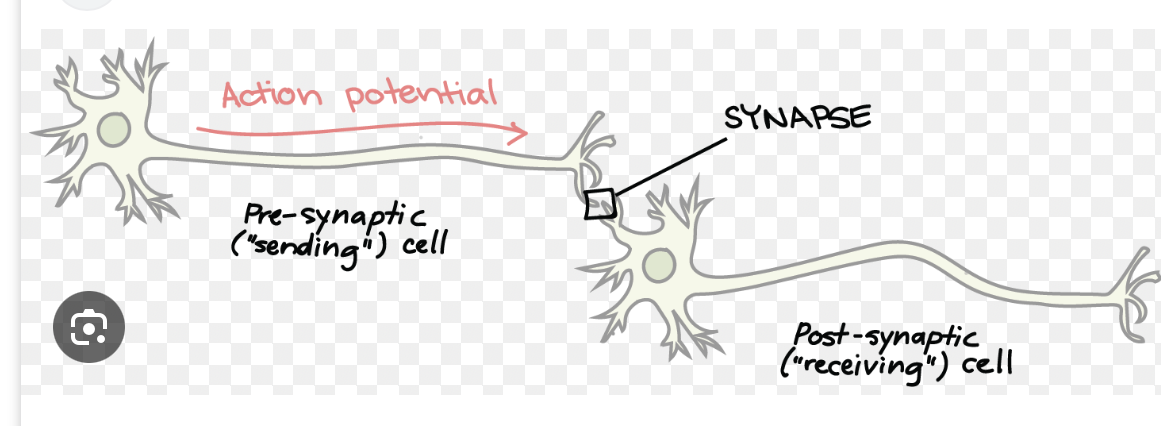Neurophysiology Introduction
1/34
Earn XP
Description and Tags
These flashcards cover essential concepts from neurophysiology, focusing on nervous system organization, neuronal function, synaptic transmission, and the properties of potentials.
Name | Mastery | Learn | Test | Matching | Spaced |
|---|
No study sessions yet.
35 Terms
How is the nervous system organized?
The nervous system is organized into the afferent division and the efferent division.
What makes up the afferent division of the nervous system?
The afferent division includes sensory neurons that send information to the central nervous system.
What makes up the efferent division of the nervous system?
The efferent division consists of motor neurons that send information from the central nervous system to effectors.
What are the effectors for each subdivision of the efferent division?
Effectors for the somatic nervous system include skeletal muscles, while effectors for the autonomic nervous system include cardiac and smooth muscles as well as glands.
Name the glia cells of the central nervous system and their functions.
The glia cells include astrocytes (support and nutrient supply), oligodendrocytes (myelination), and microglia (immune defense).
Name the glia cells of the peripheral nervous system and their functions.
The glia cells include Schwann cells (myelination) and satellite cells (support and protection of neuron cell bodies).
Compare and contrast oligodendrocytes and Schwann cells.
Oligodendrocytes are found in the central nervous system and can myelinate multiple axons, while Schwann cells are found in the peripheral nervous system and myelinate one axon.
What is the RMP of a typical neuron?
The resting membrane potential (RMP) of a typical neuron is approximately -70 millivolts (mV).
How is the resting membrane potential determined?
The resting membrane potential is determined by ion concentrations and membrane permeability, primarily involving sodium and potassium ions.
What is a graded potential?
A graded potential is a small change in the membrane potential that can lead to an action potential if the threshold is reached.
What is it called when two or more graded potentials are added together?
It is called summation.
What is a subthreshold stimulus?
A subthreshold stimulus is a weak stimulus that does not reach the threshold for action potential generation.
What is a threshold stimulus?
A threshold stimulus is a stimulus strong enough to initiate an action potential.
Why are action potentials considered ‘all or none’?
Action potentials are considered ‘all or none’ because they either occur fully or not at all once the threshold is met.
What is the action potential threshold for a typical neuron?
The action potential threshold for a typical neuron is approximately -55 millivolts (mV).
Do action potentials fade away with distance from a stimulus?
No, action potentials do not fade away; they are regenerated at each node in myelinated axons.
What about graded potentials?
Graded potentials can fade away with distance from the stimulus due to their local nature.
Describe the details of an action potential including its phases.
An action potential consists of depolarization, repolarization, and hyperpolarization phases.
What membrane channels are involved in an action potential?
Sodium (Na+) and potassium (K+) channels are involved.
When do sodium channels open during an action potential?
Sodium channels open during the depolarization phase.
When do potassium channels open during an action potential?
Potassium channels open during the repolarization phase.
What does action potential propagation mean?
Action potential propagation refers to the transmission of the action potential along the axon.
What type of homeostatic mechanism does propagation of action potentials depend on?
Propagation of action potentials depends on the all-or-none principle and the permeability changes of the membrane.
Describe continuous conduction & saltatory conduction.
Continuous conduction occurs in unmyelinated axons with a slow propagation speed; saltatory conduction occurs in myelinated axons, speeding up transmission between nodes of Ranvier.
How does myelination affect conduction speed?
Myelination increases conduction speed by allowing action potentials to jump between nodes of Ranvier.
Where are the membrane channels located on myelinated axons?
The membrane channels on myelinated axons are located at the nodes of Ranvier.
What is a synapse?
A synapse is the junction between two neurons or between a neuron and an effector.

What are the three structures making up a typical synapse?
The three structures are the presynaptic neuron, the synaptic cleft, and the postsynaptic neuron.
How are chemical synapses and electrical synapses structurally different?
Chemical synapses involve neurotransmitter release and receptor binding, while electrical synapses involve direct electrical connections between neurons.
What does it mean when the post-synaptic neuron receives a negative chemical signal?
This is called a hyperpolarizing graded potential.
What receptors accept negative chemical signals on the post-synaptic membrane?
Specific receptors for inhibitory neurotransmitters are involved.
What does it mean when the post-synaptic neuron receives a positive chemical signal?
This is called a depolarizing graded potential.
What receptors accept positive chemical signals on the post-synaptic membrane?
Specific receptors for excitatory neurotransmitters are involved.
What is the difference between spatial summation and temporal summation?
Spatial summation involves multiple pre-synaptic inputs at different locations simultaneously, while temporal summation involves multiple inputs at the same location over time.
Describe the overall process of action potential phases to production of graded potentials.
The action potential phases lead to the propagation of the signal and ultimately result in graded potentials through summation of EPSPs and IPSPs.